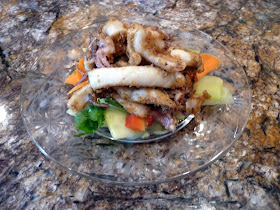This dish represents a first for me, a recipe made from something I found on Pinterest. I started using Pinterest several months ago, primarily as another source of recipes. However, I did not find much that interested me and, as often happens, I stopped going to Pinterest for ideas. Recently, however, I decided to give it another shot. I set up Pinterest Boards for Chef Bolek and started to look for recipes again.
Fortunately, I found some recipes that I wanted to try to make. One of those recipes is Fettuccine with Asparagus Puree, which I found on a board set up by Chef Marcus Samuelsson. Chef Samuelsson is one of the few chefs who I follow on various social media (like Pinterest). Chef Samuelsson has a very interesting back story. He and his sisters were born in Ethiopia, adopted by a Swedish couple and raised in Sweden. Now, Chef Samuellson is a very successful chef with restaurants that I hope to visit someday, like Red Rooster in Harlem and the American Table Brasserie and Bar in Stockholm.
Although I was never a fan of asparagus when I was a kid, I have recently began eating more of the vegetable. My preferred way of making asparagus is to grill it, but, this recipe provides an interesting twist to using those spears. This recipe places the asparagus at the center of a sauce. The other ingredients -- spinach, garlic and pine nuts -- makes this sauce into a sort of a pesto. The recipe calls for the sauce to be served with spinach fettuccine. While I would ordinarily make my own pasta, I was very happy to use some fresh, store-bought pasta. This made the recipe very quick and easy to make.
FETTUCCINE WITH ASPARAGUS PUREE RECIPE
Recipe adapted from one by Joanne Bruno,
available at Marcus Samuelsson
Ingredients:
1 bunch of asparagus, trimmed and halved crosswise
3 handfuls of baby spinach
2 cloves of garlic
1 cup of freshly grated Parmesan cheese
1 cup toasted pine nuts
1/4 cup extra virgin olive oil
1 lemon, juiced
1/2 teaspoon fine-grain sea salt
12 ounces fresh spinach fettuccine
Directions:
1. Bring water to boil. Bring two pots of salted water to a boil. Use a larger pot to cook the pasta and a smaller pot to blanch the asparagus.
2. Blanch the asparagus. Drop the asparagus into the pot of salted water. Cook for 2-3 minutes or until the spears are bright green. Transfer to a bowl of iced water. Let sit for a minute or two and drain.
3. Make the asparagus puree. Add the asparagus to the blender, along with the spinach, garlic, Parmesan cheese, and 3/4 cup of the pine nuts to the processor. Puree the ingredients. With the motor still on, drizzle in the 1/4 cup of olive oil until a paste forms. It should be the consistency of a pesto. Add in the lemon juice and salt, to taste.
4. Cook the pasta. Cook the pasta until al dente. Drain and toss with the asparagus puree. Sprinkle with the remaining pine nuts.
One final note. If you want to "Chef Bolek" this recipe, then you should add some torn prosciutto (about 1/8 of a pound per serving) over the pasta, with a healthy serving of Parmesan cheese. The addition of the prosciutto makes this very delicious vegetarian dish into an equally delicious carnivore dish.
One final note. If you want to "Chef Bolek" this recipe, then you should add some torn prosciutto (about 1/8 of a pound per serving) over the pasta, with a healthy serving of Parmesan cheese. The addition of the prosciutto makes this very delicious vegetarian dish into an equally delicious carnivore dish.
ENJOY!




















